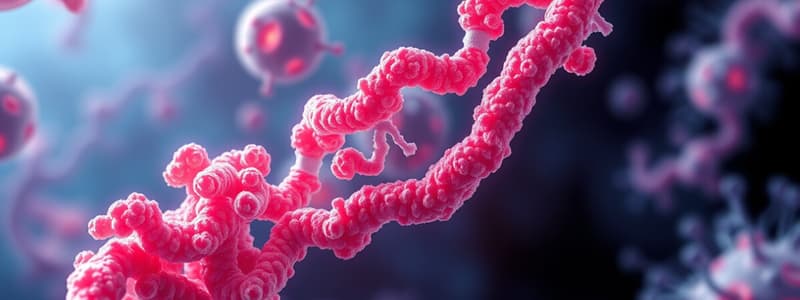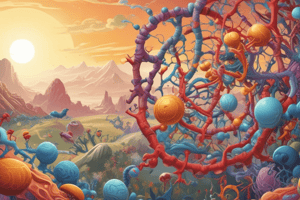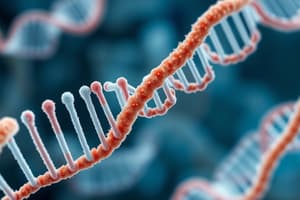Podcast
Questions and Answers
What does the start codon AUG signify in the process of translation?
What does the start codon AUG signify in the process of translation?
- The beginning of transcription
- The start of translation and establishes the codon reading frame (correct)
- The binding site for the large ribosomal subunit
- The end of the translation process
Which components are initially associated during the initiation of translation?
Which components are initially associated during the initiation of translation?
- mRNA, tRNA bearing the first amino acid, and the large ribosomal subunit
- mRNA, a tRNA bearing the first amino acid of the polypeptide, and the small ribosomal subunit (correct)
- tRNA, the start codon, and GTP
- mRNA, the ribosomal binding site, and initiation factors
What role do initiation factors play in translation initiation?
What role do initiation factors play in translation initiation?
- They replace the large ribosomal subunit during translation
- They help in the assembly of all components for the initiation complex (correct)
- They bind to the start codon and terminate translation
- They hydrolyze GTP to provide energy for translation
In eukaryotes, what sequence does the small ribosomal subunit bind to during initiation?
In eukaryotes, what sequence does the small ribosomal subunit bind to during initiation?
What energy source is required to form the translation initiation complex?
What energy source is required to form the translation initiation complex?
Where does the initiator tRNA sit within the ribosome upon completion of the initiation process?
Where does the initiator tRNA sit within the ribosome upon completion of the initiation process?
How does the small ribosomal subunit find the start codon in eukaryotes?
How does the small ribosomal subunit find the start codon in eukaryotes?
What is the result of the small ribosomal subunit's association with mRNA and initiator tRNA in bacteria?
What is the result of the small ribosomal subunit's association with mRNA and initiator tRNA in bacteria?
Which direction is a polypeptide synthesized during translation?
Which direction is a polypeptide synthesized during translation?
What role do elongation factors play during translation?
What role do elongation factors play during translation?
Which nucleotide sequences act as signals to stop translation?
Which nucleotide sequences act as signals to stop translation?
What occurs when the release factor binds to the stop codon at the A site?
What occurs when the release factor binds to the stop codon at the A site?
What does post-translational modification involve?
What does post-translational modification involve?
How does energy expenditure occur during the elongation stage of translation?
How does energy expenditure occur during the elongation stage of translation?
What happens to empty tRNAs after they are released from the E site?
What happens to empty tRNAs after they are released from the E site?
What is a key characteristic of the ribosome's movement during translation?
What is a key characteristic of the ribosome's movement during translation?
Which modification may occur to create a functional protein post-translation?
Which modification may occur to create a functional protein post-translation?
What does the hydrolization of two more GTP molecules assist with in the termination phase?
What does the hydrolization of two more GTP molecules assist with in the termination phase?
What is the role of the AUG codon in the initiation of translation?
What is the role of the AUG codon in the initiation of translation?
How does the binding of the small ribosomal subunit differ in bacteria compared to eukaryotes?
How does the binding of the small ribosomal subunit differ in bacteria compared to eukaryotes?
What is required to form the translation initiation complex?
What is required to form the translation initiation complex?
Where does the initiator tRNA positioned after the transmission initiation process is completed?
Where does the initiator tRNA positioned after the transmission initiation process is completed?
What component do initiation factors assist in bringing together during translation initiation?
What component do initiation factors assist in bringing together during translation initiation?
What is the first amino acid introduced during translation initiation?
What is the first amino acid introduced during translation initiation?
What site on the ribosome is vacant and ready for the next aminoacyl tRNA after initiation?
What site on the ribosome is vacant and ready for the next aminoacyl tRNA after initiation?
What characteristic of the small ribosomal subunit is critical for its function in eukaryotes?
What characteristic of the small ribosomal subunit is critical for its function in eukaryotes?
What happens during the elongation stage of translation?
What happens during the elongation stage of translation?
What signals the termination of translation?
What signals the termination of translation?
How does the ribosome move during the translation process?
How does the ribosome move during the translation process?
Which of the following statements is TRUE regarding the elongation cycle?
Which of the following statements is TRUE regarding the elongation cycle?
What is the role of the release factor during termination?
What is the role of the release factor during termination?
During which stage is the polypeptide chain initially folded into a three-dimensional shape?
During which stage is the polypeptide chain initially folded into a three-dimensional shape?
What addition may occur to certain amino acids during post-translational modifications?
What addition may occur to certain amino acids during post-translational modifications?
After the polypeptide is completed, what generally occurs next to ensure its functionality?
After the polypeptide is completed, what generally occurs next to ensure its functionality?
Why is GTP hydrolyzed during the elongation process?
Why is GTP hydrolyzed during the elongation process?
Which of the following codons acts as a stop signal during translation?
Which of the following codons acts as a stop signal during translation?
Study Notes
Ribosome Association and Translation Initiation
- The start codon AUG signals the beginning of translation, crucial for establishing the mRNA reading frame.
- In bacteria, the small ribosomal subunit binds to mRNA and initiator tRNA in any order; it recognizes a specific RNA sequence upstream of the AUG.
- In eukaryotes, the small subunit, along with the initiator tRNA, attaches to the 5’ cap of the mRNA and scans downstream to locate the AUG.
- Initiation factors are proteins essential for assembling the translation initiation complex, involving mRNA, tRNA, and the small ribosomal subunit.
- Energy from GTP hydrolysis is required to form the initiation complex, which positions the initiator tRNA in the P site, leaving the A site open for the next tRNA.
Elongation of the Polypeptide Chain
- The elongation phase involves the sequential addition of amino acids to the growing polypeptide chain at the C-terminus.
- This process occurs through a three-step cycle involving elongation factors and requires energy, primarily from GTP hydrolysis, enhancing accuracy.
- The ribosome moves unidirectionally along the mRNA (5' to 3'), corresponding to the codon sequence.
- The elongation cycle is rapid, taking less than a tenth of a second in bacteria for each amino acid addition.
- Released empty tRNAs from the E site return to the cytoplasm for reloading with new amino acids.
Termination of Translation
- Translation termination is initiated when a stop codon (UAG, UAA, UGA) occupies the A site.
- A release factor, resembling tRNA, binds to the stop codon, leading to the addition of a water molecule rather than an amino acid.
- This reaction hydrolyzes the bond between the completed polypeptide and the tRNA in the P site, releasing the polypeptide.
- The translation assembly disassembles through a multistep process, requiring the hydrolysis of two additional GTP molecules.
Completing and Targeting Functional Proteins
- Translation alone does not ensure the formation of functional proteins; further modifications are often necessary.
- Polypeptide chains begin to fold and coil spontaneously during synthesis, shaped by their amino acid sequence (primary structure).
- Post-translational modifications may include the attachment of sugars, lipids, or phosphate groups to specific amino acids.
- Enzymatic processes can remove amino acids from the leading end or cleave polypeptide chains into multiple pieces.
- Polypeptides with quaternary structures, like hemoglobin, may form by the assembly of separate polypeptide chains.
Ribosome Association and Translation Initiation
- The start codon AUG signals the beginning of translation, crucial for establishing the mRNA reading frame.
- In bacteria, the small ribosomal subunit binds to mRNA and initiator tRNA in any order; it recognizes a specific RNA sequence upstream of the AUG.
- In eukaryotes, the small subunit, along with the initiator tRNA, attaches to the 5’ cap of the mRNA and scans downstream to locate the AUG.
- Initiation factors are proteins essential for assembling the translation initiation complex, involving mRNA, tRNA, and the small ribosomal subunit.
- Energy from GTP hydrolysis is required to form the initiation complex, which positions the initiator tRNA in the P site, leaving the A site open for the next tRNA.
Elongation of the Polypeptide Chain
- The elongation phase involves the sequential addition of amino acids to the growing polypeptide chain at the C-terminus.
- This process occurs through a three-step cycle involving elongation factors and requires energy, primarily from GTP hydrolysis, enhancing accuracy.
- The ribosome moves unidirectionally along the mRNA (5' to 3'), corresponding to the codon sequence.
- The elongation cycle is rapid, taking less than a tenth of a second in bacteria for each amino acid addition.
- Released empty tRNAs from the E site return to the cytoplasm for reloading with new amino acids.
Termination of Translation
- Translation termination is initiated when a stop codon (UAG, UAA, UGA) occupies the A site.
- A release factor, resembling tRNA, binds to the stop codon, leading to the addition of a water molecule rather than an amino acid.
- This reaction hydrolyzes the bond between the completed polypeptide and the tRNA in the P site, releasing the polypeptide.
- The translation assembly disassembles through a multistep process, requiring the hydrolysis of two additional GTP molecules.
Completing and Targeting Functional Proteins
- Translation alone does not ensure the formation of functional proteins; further modifications are often necessary.
- Polypeptide chains begin to fold and coil spontaneously during synthesis, shaped by their amino acid sequence (primary structure).
- Post-translational modifications may include the attachment of sugars, lipids, or phosphate groups to specific amino acids.
- Enzymatic processes can remove amino acids from the leading end or cleave polypeptide chains into multiple pieces.
- Polypeptides with quaternary structures, like hemoglobin, may form by the assembly of separate polypeptide chains.
Studying That Suits You
Use AI to generate personalized quizzes and flashcards to suit your learning preferences.
Description
This quiz explores the critical process of translation initiation in both bacteria and eukaryotes, focusing on the role of the start codon and ribosomal subunits. Examine how these elements interact during the initiation phase of protein synthesis. Test your knowledge on the specific sequences and mechanisms involved in this essential biological process.




